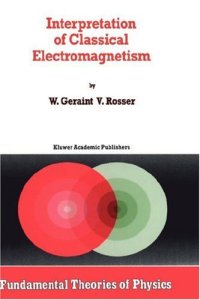
Ebook: Interpretation of Classical Electromagnetism
Author: W. Geraint V. Rosser (auth.)
- Genre: Physics // Electrodynamics
- Tags: Theoretical Mathematical and Computational Physics, Electrical Engineering, Mathematics general, History and Philosophical Foundations of Physics, Philosophy of Science
- Series: Fundamental Theories of Physics 78
- Year: 1997
- Publisher: Springer Netherlands
- Edition: 1
- Language: English
- pdf
The aim of this book is to interpret all the laws of classical electromagnetism in a modern coherent way. In a typical undergraduate course using vector analysis, the students finally end up with Maxwell's equations, when they are often exhausted after a very long course, in which full discussions are properly given of the full range of applications of individual laws, each of which is important in its own right. As a result, many students do not appreciate how limited is the experimental evidence on the basis of which Maxwell's equations are normally developed and they do not always appre ciate the underlying unity of classical electromagnetism, before they go on to graduate courses in which Maxwell's equations are taken as axiomatic. This book is designed to be used between such an undergraduate course and graduate courses. It is written by an experimental physicist and is intended to be used by physicists, electrical engineers and applied mathematicians.
This book presents Maxwell's equations and the laws of classical electromagnetism starting from the equations for the electric and magnetic fields due to an accelerating classical point charge. A microscopic perspective is used to interpret the electric field due to a current element, the origin of induced electromagnetic fields and detached electric field lines, motional electromagnetic fields, the mode of action of inductors and capacitors in AC circuits, conduction current flow, the Biot-Savart law, etc. A review of energy methods is presented in a way consistent with this microscopic approach, leading up to discussions of the conservation laws for a system of spatially separated moving charges and the Poynting vector hypothesis. After extending Maxwell's equations to field points inside dielectrics and magnetic materials, a brief review of special relativity is given stressing those topics that illustrate the essential unity of classical electromagnetism and special relativity. Audience: This textbook is designed to be used between a course in classical electromagnetism in which vector analysis has been introduced, and an advanced graduate course in electromagnetism. It will also be of interest to research physicists and to graduate students as a complement to more traditional courses.